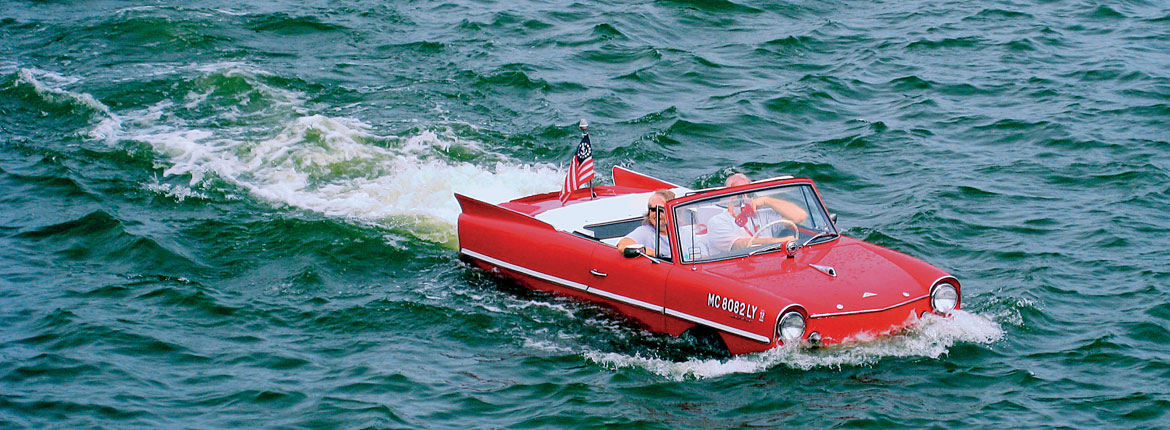One of the highlights of any James Bond movie is seeing the extravagant and far-fetched gadgets that the super-spy’s cars get equipped with.
The most well-known of all the Bond cars is, of course, the mid-60s Aston Martin DB5 with retractable machine guns, tyre slashers and a passenger ejector seat. The Aston had all the offensive and defensive bells and whistles demanded by a playboy spy.
One of my favourite 007 vehicles appeared in the 1976 movie The Spy Who Loved Me. To escape the villains on land and in water, Bond got behind the wheel of a Lotus Esprit.
But this was no ordinary Esprit…
Yes, it was equipped with the mandatory guns and rockets, but what separated it from all the others was its amphibious ability. It could travel both on and under the water. At the flick of a switch the Esprit essentially turned into a submarine. Fantastic!
Sadly this was a 'made for the movies' fictional creation which didn’t actually have any amphibious qualities at all. To shoot the water scenes a specially designed submarine was built in the shape of a Lotus Esprit. Being a 'wet-sub' it required the occupants to wear SCUBA gear.
But water-going cars are not the sole domain of fictional spies. There have been many real amphibious vehicles built over the years.
The earliest claimed example was a steam-powered dredge, commissioned in 1804 by the Philadelphia City Council for deepening the Delaware River Dock. It was known as the Orukter Amphibolos (Amphibious Digger), but despite the amphibious claims, in truth, it was a 17 ton barge which had wheels fitted to get it to the river. It only ran on land that one time, so calling it an amphibious vehicle is drawing a rather long bow.
Various steam-powered logging barges with limited on-land capability followed. With the advent of the internal combustion engine, determined home-builders also had the odd crack at it in the early part of the 20th century.
It wasn’t until the outbreak of World War II that any successful mass-produced amphibian vehicles came about. The German army had their Landwasserschlepper (Land-Water-Tractor), a massive machine powered by a 12 cylinder, 300hp Maybach engine, capable of 35km/h on land and 12km/h in water.
The Americans, with a need to unload cargo, ammunition and supplies from ship to shore, adapted a two-and-a-half ton GM truck into an amphibious landing craft known as the DUKW – which became known by the troops as the 'Duck'.
The US army Jeep (dubbed the 'Seep') was also adapted for marine use. However, they were too light and unstable and so they capsized easily in the waves.
The Type 166 Schwimmwagen was used extensively by German ground forces and remains the most numerous amphibious vehicle produced. Using running gear from the 4WD Volkswagen Kubelwagen, a total of 15,584 Schwimmwagens were produced; 14,276 by the Volkswagen factory at Wolfsberg and 1,308 by Porsche in Stuttgart.
Only 163 are known to remain today, with one example residing in New Zealand, displayed at the Southward Car Museum at Paraparaumu. During peace time it’s the Amphicar Model 770, designed by Hanns Trippel and manufactured in Germany, that has found the greatest success.
Just under 4,000 Amphicars were built between 1961 and 1965, with the majority being sold in America. The renowned joker President Lyndon Johnson was an early adopter and was known to play pranks on his passengers by driving his Amphicar into a lake on his estate after pretending the brakes had failed.
Powered by a 1,147cc engine from the British Triumph Herald, the Amphicar was capable of seven knots in the water and 70mph on land, hence the designation 770. Twin propellers mounted under the rear bumper were engaged by a separate gear lever and the front wheels doubled as rudders, so manoeuvrability was compromised.
Time magazine called it a “vehicle that revolutionised drowning,” but it still had its fans who claimed it to be as watertight as any boat, if kept properly maintained. Proof of this is the fact that a pair of Amphicars crossed the English Channel in 1968, conquering 6.1m seas and gale force winds in an epic six-hour journey.
Like the Schwimmwagen, New Zealand is also home to an Amphicar. A nice example is on display at Hamilton’s Classic Car Museum.
But New Zealand isn’t home to only foreign amphibious cars. The most famous amphibian on the global stage in the 21st century is the Gibbs Aquada, the brainchild of Kiwi entrepreneur, Alan Gibbs.
The Aquada is arguably the most advanced of all amphibious vehicles, being purpose-built for the task. It’s powered by a Rover V6 engine and can reach speeds of over 160km/h on land and 50km/h in water.
In 2004, the wealthy English businessman Sir Richard Branson set a new cross-channel record in an amphibious vehicle in his Gibbs Aquada. He managed to cut four hours and 20 minutes off the previous record, completing the crossing from England to France in just one hour and 40 minutes.
Just like electric and self-driving cars, amphibious vehicles are not just futuristic fantasies. Now when will we see a flying car?
Reported by Andrew Bayliss for our AA Directions Autumn 2024 issue




